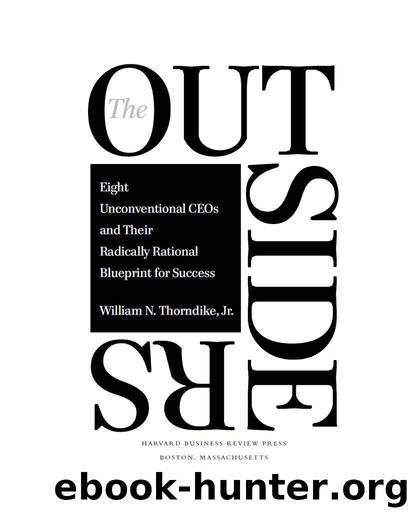The Outsiders: Eight Unconventional CEOs and Their Radically Rational Blueprint for Success by Thorndike William N

Author:Thorndike, William N. [Thorndike, William N.]
Language: eng
Format: epub, mobi
Publisher: Harvard Business Review Press
Published: 2012-10-01T14:00:00+00:00
“In those days, buying back stock was very unusual.”—George Gillespie
Source: Compustat and Center for Research in Security Prices (CRSP).
Ironically, in the early 1980s, the management consulting firm McKinsey advised the company to halt its buyback program. Graham followed McKinsey’s advice for a little over two years, before, with Buffett’s help, coming to her senses and resuming the repurchase program in 1984. Donald Graham reckons this high-priced McKinsey wisdom cost Post shareholders hundreds of millions of dollars of value, calling it the “most expensive consulting assignment ever!”
. . .
On the broader topic of resource allocation, one of Graham’s defining managerial traits was a unique ability to identify and attract talent to her company and her board. Although she could seem aloof, she had terrific people instincts, and as Alan Spoon told me, “She was a consummate ‘convener.’”7 While some of these people were paragons of the establishment—including directors such as former defense secretary Robert McNamara, and a succession of lawyers from the white-shoe firm of Cravath, Swaine in New York—many of her choices were decidedly unconventional. Two in particular stand out.
First, in 1967, as we’ve seen, she tapped Ben Bradlee, a young and relatively unknown Newsweek assistant managing editor, to replace longtime Post editor in chief Russ Wiggins. It’s hard to overstate the unconventionality of this decision. Probably the most important personnel decision the head of a newspaper company makes is the choice of an editor in chief, the person with overall responsibility for the content and voice of the paper. Graham had concluded that she needed a younger editor, one more attuned to the rapidly changing political landscape and culture of the late 1960s. When she first mentioned the idea to the salty Bradlee over lunch, he famously responded, “I’d give my left one for that job.” Bradlee, who had no prior newspaper management experience, could not have been more different from the distinguished, professorial Wiggins.
He would, however, prove to be a bold and intuitive editor who would lead the paper through the glory and turmoil of its 1970s scoops. He was also a magnet for attracting top young journalistic talent to the paper. This influx of talent, along with innovations such as the introduction of the country’s first style section, led to consistent circulation gains through the 1970s and into the 1980s, providing a critical engine of profit growth for the company.
Her second decision occurred during the severe bear market of 1974, when a new investor accumulated a large chunk of the Post’s stock, causing ripples of anxiety at the company. The board in particular was suspicious of this newcomer and his intentions. Graham had inherited a board composed of experienced local businessmen and cronies of her husband’s. Although increasingly assertive in journalistic matters, she still frequently deferred to their judgment and advice on business matters.
In this case, however, she struck out on her own and decided to meet with the new investor. To her credit, she immediately recognized his unique abilities, and against her board’s advice, she invited
Download
The Outsiders: Eight Unconventional CEOs and Their Radically Rational Blueprint for Success by Thorndike William N.mobi
This site does not store any files on its server. We only index and link to content provided by other sites. Please contact the content providers to delete copyright contents if any and email us, we'll remove relevant links or contents immediately.
Hit Refresh by Satya Nadella(8852)
The Compound Effect by Darren Hardy(8504)
Change Your Questions, Change Your Life by Marilee Adams(7371)
Nudge - Improving Decisions about Health, Wealth, and Happiness by Thaler Sunstein(7239)
The Black Swan by Nassim Nicholas Taleb(6761)
Deep Work by Cal Newport(6562)
Daring Greatly by Brene Brown(6221)
Rich Dad Poor Dad by Robert T. Kiyosaki(6174)
Principles: Life and Work by Ray Dalio(5956)
Man-made Catastrophes and Risk Information Concealment by Dmitry Chernov & Didier Sornette(5645)
Playing to Win_ How Strategy Really Works by A.G. Lafley & Roger L. Martin(5491)
Digital Minimalism by Cal Newport;(5389)
Big Magic: Creative Living Beyond Fear by Elizabeth Gilbert(5350)
The Myth of the Strong Leader by Archie Brown(5236)
The Slight Edge by Jeff Olson(5199)
Discipline Equals Freedom by Jocko Willink(5156)
The Motivation Myth by Jeff Haden(5000)
Stone's Rules by Roger Stone(4852)
The Laws of Human Nature by Robert Greene(4770)
